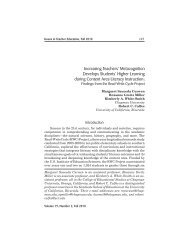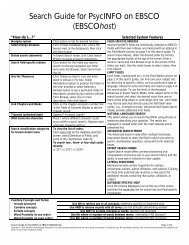e-Research: A Journal of Undergraduate Work - Chapman University
e-Research: A Journal of Undergraduate Work - Chapman University
e-Research: A Journal of Undergraduate Work - Chapman University
Create successful ePaper yourself
Turn your PDF publications into a flip-book with our unique Google optimized e-Paper software.
A. Barrett, C. Rakovski<br />
This protocol depends on a single parameter that denotes the number <strong>of</strong> ACs. We simulated 100,000<br />
implementations <strong>of</strong> this strategy for 5, 6, 7, 8, 9, and 10 assistant counters. Our results show that the optimal<br />
version <strong>of</strong> this design is attained by 8 counters and the corresponding average number <strong>of</strong> days until the leader<br />
declares victory is 2123 (an improvement <strong>of</strong> 916 days or 30% over the fastest variant <strong>of</strong> protocol 2) with standard<br />
deviation <strong>of</strong> 353. The execution <strong>of</strong> protocol 3 took as few as 985 and as many as 4271 with median <strong>of</strong> 2093 days<br />
(summary statistics presented in Table 2).<br />
4. Multiple Dynamically Selected Counters Protocol<br />
In essence, this protocol combines and exploits the advantageous properties <strong>of</strong> strategies 2 and 3. This scheme<br />
starts with m consecutive snowball rounds designed to dynamically elect m counters (the leader and the remaining<br />
m-1 assistant counters). After the end <strong>of</strong> all snowball rounds, the m counters have been selected and the protocol<br />
continues with stage 2 in a fashion identical to that <strong>of</strong> protocol 4. As mentioned earlier, based on an additional<br />
simulation study, during the first 71 days, the probability <strong>of</strong> selecting a new prisoner is greater than the probability<br />
<strong>of</strong> selecting a repeated visitor which shows that the successive snowball rounds should extend around 71 days in<br />
total. Further, we completed a separate simulation study (results not presented) to assess the average number <strong>of</strong><br />
days necessary for the switch to consecutively fill up. Based on these two ancillary results, for 7, 6, 5 and 4<br />
snowball rounds, we define the following snowball round lengths (26,11,9,8,7,7,6), (28,12,10,9,8,7),<br />
(30,14,11,10,9) and (33,16, 13,13) respectively. Lastly, we determine and assign the corresponding quotas to the<br />
counters by uniformly distributing the expected number <strong>of</strong> uncollected tokens which produces the following<br />
values (29,15,13,12,11,11,9), (30,17,15,14,12,12), (33,20,17,16,14) and (37,24,20,19).<br />
This protocol depends on a several parameters, number <strong>of</strong> snowball rounds, snowball rounds lengths, and quota<br />
values. In this analysis, we simulated 100,000 implementations <strong>of</strong> this strategy for 4, 5, 6 and 7 snowball rounds<br />
and fixed the corresponding lengths and quotas to the values determined by the above-mentioned arguments. Our<br />
results show that the optimal version <strong>of</strong> this design is attained for 6 snowball rounds and the corresponding<br />
average number <strong>of</strong> days until the leader declares victory is 1871 (an improvement <strong>of</strong> 252 days or 12% over the<br />
fastest variant <strong>of</strong> protocol 3) with standard deviation <strong>of</strong> 374. The execution <strong>of</strong> protocol 4 took as few as 816 and as<br />
many as 4727 with median <strong>of</strong> 1871 days (summary statistics presented in Table 3).<br />
60 e-<strong>Research</strong>, Vol 2, No 2 (2011)







